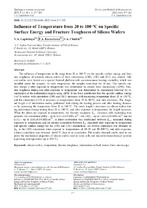| dc.contributor.author | Lapitskaya, V. A. | |
| dc.contributor.author | Kuznetsova, T. A. | |
| dc.contributor.author | Chizhik, S. A. | |
| dc.coverage.spatial | Минск | ru |
| dc.date.accessioned | 2023-12-12T11:10:25Z | |
| dc.date.available | 2023-12-12T11:10:25Z | |
| dc.date.issued | 2023 | |
| dc.identifier.citation | Lapitskaya, V. A. Influence of Temperature from 20 to 100 °C on Specific Surface Energy and Fracture Toughness of Silicon Wafers = Влияние температуры от 20 до 100 °С на удельную поверхностную энергию и вязкость разрушения пластин кремния / V. A. Lapitskaya, T. A. Kuznetsova, S. A. Chizhik // Приборы и методы измерений. – 2023. – Т. 14, № 4. – С. 277-283. | ru |
| dc.identifier.uri | https://rep.bntu.by/handle/data/138378 | |
| dc.description.abstract | The influence of temperature in the range from 20 to 100 °C on the specific surface energy and fracture toughness of standard silicon wafers of three orientations (100), (110) and (111) was studied. Silicon wafers were heated on a special thermal platform with an autonomous heating controller, which was installed under the samples. At each temperature, the samples were kept for 10 min. The specific surface energy γ after exposure to temperature was determined by atomic force microscopy (AFM). Fracture toughness during and after exposure to temperature was determined by indentation followed by visualization of the deformation region using AFM. It has been established that the specific surface energy γ of Si wafers with orientation (100) and (111) increases with increasing temperature from 20 to 100 °C, and for orientation (110) it increases at temperatures from 20 to 80 °C, and then decreases. The diagonal length d of indentation marks, performed both during the heating process and after heating, decreases by increasing the temperature from 20 to 100 °C. The crack length c decreases on silicon wafers during indentation during heating from 20 to 100 °C, and after exposure to temperature, the length increases. When the plates are exposed to temperature, the fracture toughness KIC increases with increasing temperature: for orientation (100) – up to 1.61 ± 0.08 MPa·m1/2, for (110) – up to 1.60 ± 0.08 MPa·m1/2 and for (111) – up to 1.66 ± 0.04 MPa·m1/2. A direct correlation was established between KIC , measured during exposure to temperature, and an inverse correlation between KIC measured after exposure to temperature and specific surface energy for the (100) and (111) orientations. An inverse correlation was obtained by KIC at the (110) orientation when exposed to temperatures of 20–40 and 80–100 °C, and after exposure, a direct correlation was obtained. At 60 °C there is no correlation. The results obtained can be used to improve the mechanical properties of silicon wafers used in solar cells and microelectromechanical systems (operating at temperatures up to 100 °C). | ru |
| dc.language.iso | en | ru |
| dc.publisher | БНТУ | ru |
| dc.title | Influence of Temperature from 20 to 100 °C on Specific Surface Energy and Fracture Toughness of Silicon Wafers | ru |
| dc.title.alternative | Влияние температуры от 20 до 100 °С на удельную поверхностную энергию и вязкость разрушения пластин кремния | ru |
| dc.type | Article | ru |
| dc.identifier.doi | 10.21122/2220-9506-2023-14-4-277-283 | |
| local.description.annotation | Проведены исследования влияния температуры в диапазоне от 20 до 100 °С на удельную поверхностную энергию и вязкость разрушения стандартных пластин кремния трёх ориентаций (100), (110) и (111). Пластины кремния нагревали на специальной термоплатформе с автономным контроллером нагрева, которую устанавливали под образцы. При каждой температуре образцы выдерживали в течении 10 мин. Удельная поверхностная энергия γ после воздействия температуры определялась методом атомно-силовой микроскопии (АСМ). Вязкость разрушения во время и после воздействия температуры определялась методом индентирования с последующей визуализацией области деформации методом АСМ. Установлено, что удельная поверхностная энергия γ пластин кремния ориентации (100) и (111) увеличивается с увеличением температуры от 20 до 100 °С, у ориентации (110) – увеличивается при температурах от 20 до 80 °С, а затем снижается. Длина диагонали d отпечатков индентирования, выполняемых как в процессе нагрева, так и после нагрева, уменьшается с увеличением температуры от 20 до 100 °С. Длина трещин c уменьшается на пластинах кремния при индентировании во время нагрева от 20 до 100 °С, а после воздействия температуры длина увеличивается. Во время воздействия температуры на пластины вязкость разрушения KIC увеличивается с увеличением температуры: для ориентации (100) – 1,61 ± 0,08 MПa·м1/2, для (110) – до 1,60 ± 0,08 MПa·м1/2 и для (111) – до 1,66 ± 0,04 MПa·м1/2. Установлена прямая корреляция KIC , измеренной во время воздействия температуры, и обратная корреляция KIC , измеренной после воздействия температуры, c удельной поверхностной энергией для ориентаций (100) и (111). Обратная корреляция KIC с γ получена на ориентации (110) при воздействии температур 20–40 и 80–100 °С, а после воздействия – прямая корреляция. При 60 °С корреляции нет. Полученные результаты могут быть использованы для улучшения механических свойств кремниевых пластин, используемых в солнечных элементах и микроэлектромеханических системах (работающих при температурах до 100 °С). | ru |

